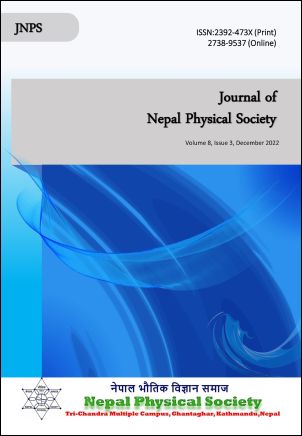Fabrication of Gas Sensor Based on Graphene for the Adsorption of Gases Produced from Waste Material in Kitchen and its Surrounding
DOI:
https://doi.org/10.3126/jnphyssoc.v8i3.50719Keywords:
Graphene, Liquid exfoliation, Dimethyl-formamide, Raman spectroscopy, Gas sensorAbstract
Graphene attracted to the researcher with huge attention due to their unique physicochemical properties including high specific surface area and high-speed electron mobility at room temperature. The graphene with several layers was synthesized through liquid phase exfoliation method using high shear force of the magnetic stirrer. This process was performed about 6 hour on the graphite powder and dimethyl-formamide solvent of 0.25 M, 0.5 M and 1 M concentration solution following the microwave treatment for 30 second and sonication for 2 hour at room temperature. The drop-casted exfoliated graphene into glass substrate had G peak and 2D peak. The graphene from 1M concentration had the better quality as compared to the graphene obtained from 0.25M and 0.5M concentration solution. The fabricated gas sensor device with two contact electrodes using exfoliated graphene as a channel material produced the different current (I)–voltage (V) characteristics. The current vs. voltage of bare graphene film without filling of waste harmful gases had the current shifted from 0 mA to 0.0652 mA when the maximum voltage was applied. The current increased nearly from 0.0652 mA to 0.2391 mA after harmful waste gases adjustment at maximum applied voltage. The current through few layers graphene channel after harmful gases filled was found 3.6 times higher than that of the current through the graphene channel without harmful waste gases. This result was due to the adsorption/absorption and interaction of more quantity of harmful waste gases by the exfoliated graphene. So, the device showing some current variation informed that the graphene gas sensor was sensitive to waste gases produced from home kitchen and its surrounding.
Downloads
Downloads
Published
How to Cite
Issue
Section
License
All right reserved. No part of this Journal may be reproduced in any form or by any electronic or mechanical means, including information storage and retrieval system, without permission in writing from the publisher, except by a reviewer who may quote brief passage in a review. The views and interpretation in this journal are those of author(s) and they are not attributable to the NPS.




